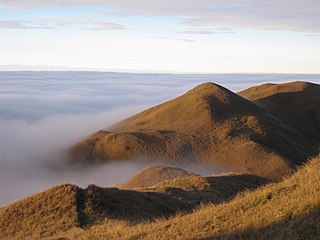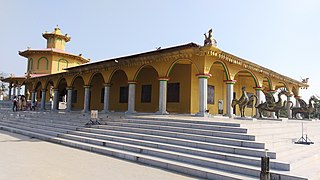
The Akha are an ethnic group who live in small villages at higher elevations in the mountains of Thailand, Myanmar, Laos and Yunnan Province in China. They made their way from China into Southeast Asia during the early 20th century. Civil war in Burma and Laos resulted in an increased flow of Akha immigrants and there are now 80,000 people living in Thailand's northern provinces of Chiang Rai and Chiang Mai.
A gope board is a wooden ritual object made in the Papuan Gulf of New Guinea. Each board represents the spirit of an ancestral hero that can protect clans from evil spirits and death.
The diverse culture of Ivory Coast, a coastal West African country bordered by Ghana, Liberia, Mali, Burkina Faso, and Guinea, is exemplified by a multitude of ethnic groups, events, festivals, music, and art.

Cordyline fruticosa is an evergreen flowering plant in the family Asparagaceae. The plant is of great cultural importance to the traditional inhabitants of the Pacific Islands and Island Southeast Asia. It is also cultivated for food, traditional medicine, and as an ornamental for its variously colored leaves. It is identified by a wide variety of common names, including ti plant, palm lily, cabbage palm.

The culture of Papua New Guinea is complex and multifaceted. It is estimated that more than 7000 different cultural groups exist in Papua New Guinea, and most groups have their own language. Because of this diversity, in which they take pride, many different styles of cultural expression have emerged; each group has created its own expressive forms in art, dance, weaponry, costumes, singing, music, architecture and much more. To unify the nation, the language Tok Pisin, once called Neo-Melanesian has evolved as the lingua franca — the medium through which diverse language groups are able to communicate with one another in Parliament, in the news media, and elsewhere. People typically live in villages or dispersed hamlets which rely on the subsistence farming of yams and taro. The principal livestock in traditional Papua New Guinea is the oceanic pig.

The Igala people are a Yoruboid ethnolinguistic group native to the region immediately south of the confluence of the Niger and Benue Rivers in central Nigeria. The area inhabited primarily by the Igala is referred to as Igalaland. Situated in an especially ecologically diverse region of Nigeria, the Igala have traditionally engaged in crop cultivation, and have been influenced culturally by many surrounding cultures over the centuries. Today, people of Igala descent are estimated to be at a population of 1.68 million people.

Indigenous Philippine folk religions are the distinct native religions of various ethnic groups in the Philippines, where most follow belief systems in line with animism. Generally, these Indigenous folk religions are referred to as Anito or Anitism or the more modern and less ethnocentric Dayawism, where a set of local worship traditions are devoted to the anito or diwata, terms which translate to gods, spirits, and ancestors. Many of the narratives within the indigenous folk religions are orally transmitted to the next generation, but many have traditionally been written down as well. The Spanish have claimed that the natives did not have religious writings, but records show otherwise. Accounts, both from Chinese and Spanish sources have explicitly noted the existence of indigenous religious writings. There are also Spanish records of indigenous religious books and scrolls, along with indigenous statues of gods, being burned by colonizers. In some sources, the Spanish claim that no such religious writings exist, while within the same chronicle, they record such books being burned on their own order. The writings were written on native reeds and leaves using iron points and other local pens, similar to how things are written on a papyrus. 0.23% of the population of the Philippines are affiliated with the Indigenous Philippine folk religions according to the 2020 national census, an increase from the previous 0.19% from the 2010 census.
Gogodala is the name of an ethnic/language group from the Middle Fly District of the Western Province of Papua New Guinea. They speak the Gogodala language, which belongs to the Trans-New Guinea language family. It is one of about a thousand distinct ethnic groups in the country, each which has its own language and culture.

The Asmat are an ethnic group of New Guinea, residing in the province of South Papua, Indonesia. The Asmat inhabit a region on the island's southwestern coast bordering the Arafura Sea, with lands totaling approximately 18,000 km2 (7,336 mi2) and consisting of mangrove, tidal swamp, freshwater swamp, and lowland rainforest.

The beliefs and practices of African people are highly diverse, including various ethnic religions. Generally, these traditions are oral rather than scriptural and are passed down from one generation to another through folk tales, songs, and festivals, and include beliefs in spirits and higher and lower gods, sometimes including a supreme being, as well as the veneration of the dead, and use of magic and traditional African medicine. Most religions can be described as animistic with various polytheistic and pantheistic aspects. The role of humanity is generally seen as one of harmonizing nature with the supernatural.

Haus Tambaran is a Tok Pisin phrase which describes a type of traditional ancestral worship house in the East Sepik region of Papua New Guinea. The most visually recognizable forms are from the Maprik area, with a tall and elaborately decorated front entrance wall where the ridge pole slopes down low toward the back of the building and the roof follows this decline and often continues all the way to the ground. The Sepik people are renowned for their superb artistic ability in painting and carving, which is often exhibited in these religious structures.

Papua New Guinean art refers to visual art created in Papua New Guinea or by Papua New Guinean artists. Papua New Guinea has been inhabited by humans for roughly 50,000 years; throughout that period, the hundreds of distinct ethnic groups of the island developed unique artistics traditions and styles. Statues and figurines, ritual masks, carvings, and weavings, all generally with spiritual and religious significance, comprise a majority of the art created historically in Papua New Guinea. In the late 20th century, a contemporary art movement emerged roughly the same time as the country gained its independence in the 1970s. This movement reflected both the nation's tribal traditions and customs as well as its progression towards modernization.

The Tai folk religion, Satsana Phi or Ban Phi is the ancient native ethnic religion of Tai people still practiced by various Tai groups. Tai folk religion was dominant among Tai people in Asia until the arrival of Buddhism and Hinduism. It is primarily based on worshipping deities called Phi, Khwan and Ancestors.
In 1994, Jim Mason, a graduate student in the Department of Anthropology at Stanford University, arranged for two groups of men from the Sepik River region of Papua New Guinea to carve the New Guinea Sculpture Garden at Stanford University. The men were from several communities or villages of the Iatmul people and the Kwoma people.
The Urapmin people are an ethnic group numbering about 375 people in the Telefomin District of the West Sepik Province of Papua New Guinea. One of the Min peoples who inhabit this area, the Urapmin share the common Min practices of hunter-gatherer subsistence, taro cultivation, and formerly, an elaborate secret cult available only to initiated men.

The Sepik is the longest river on the island of New Guinea, and the second largest in Oceania by discharge volume after the Fly River. The majority of the river flows through the Papua New Guinea (PNG) provinces of Sandaun and East Sepik, with a small section flowing through the Indonesian province of Papua.

Shamanism among Alaska Natives was particularly important as it served to construct their special connection to their land, and a kinship with the animals with whom they share that land. Before the introduction of western culture and the religions that are now practiced in Alaska, there was a common spiritual connection made with the people to the land they occupied. The most common name for this connection is shamanism. Shamanism differs in every culture where it is practiced, in Alaska it is centered in the animals that are common in the area. Through the use of many myths, stories, and ceremonies these animals are personified and their spirits made tangible and in turn are deeply woven within the Native Alaska people today. It was through the shaman that the spirit world was connected to the natural world. A shaman in Alaska Native culture was a mediator, healer and the spirit worlds’ mouthpiece. Although shamanism is no longer popularly practiced, it was and continues to be the heart of the Native Alaskan people.

The Iatmul are a large ethnic group of about 10,000 people inhabiting some two-dozen politically autonomous villages along the middle Sepik River in Papua New Guinea. The communities are roughly grouped according to dialect of the Iatmul language as well as sociocultural affinities. The Iatmul are best known for their art, men's houses, male initiation, elaborate totemic systems, and a famous ritual called naven, first studied by Gregory Bateson in the 1930s. More recently, Iatmul are known as a location for tourists and adventure travellers, and a prominent role in the 1988 documentary film Cannibal Tours.

Kundu is a pidgin name in Papua New Guinea for an hourglass drum used to accompany formal occasions, religious ceremonies and for celebrations. This drum is emblematic of Papua New Guinea and it appears on the country's coat of arms.

The traditional architecture of Papua New Guinea (PNG) reflects the diversity and ingenuity of this Pacific Island nation, with over 850 different ethnic groups each with its own distinct architectural styles, techniques, and materials. Their typical buildings range from houses on stilts to ceremonial and spiritual centers.

















